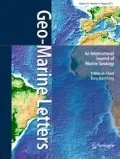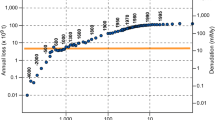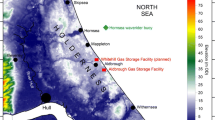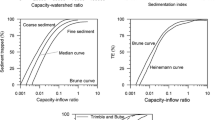Abstract
An application of the grain size trend analysis (GSTA) is used in an exploratory approach to characterize sediment transport on Camposoto beach (Cádiz, SW Spain). In May 2009 the mesotidal beach showed a well-developed swash bar on the upper foreshore, which was associated with fair-weather conditions prevailing just before and during the field survey. The results were tested by means of an autocorrelation statistical test (index I of Moran). Two sedimentological trends were recognized, i.e. development towards finer, better sorted and more negatively skewed sediment (FB–), and towards finer, better sorted and less negatively or more positively skewed sediment (FB+). Both vector fields were compared with results obtained from more classical approaches (sand tracers, microtopography and current measurements). This revealed that both trends can be considered as realistic, the FB+ trend being identified for the first time in a beach environment. The data demonstrate that, on the well-developed swash bar, sediment transported onshore becomes both finer and better sorted towards the coast. On the lower foreshore, which exhibits a steeper slope produced by breaking waves, the higher-energy processes winnow out finer particles and thereby produce negatively skewed grain-size distributions. The upper foreshore, which has a flatter and smoother slope, is controlled by lower-energy swash-backwash and overwash processes. As a result, the skewness of the grain-size distributions evolves towards less negative or more positive values. The skewness parameter appears to be distributed as a function of the beach slope and, thus, reflects variations in hydrodynamic energy. This has novel implications for coastal management.

GSTA model for Camposoto Beach, Cádiz, with FB– (finer, better sorted, more negatively skewed) and FB+ (finer, better sorted, less negatively/more positively skewed) textural trends dominating the lower and upper foreshore respectively








Similar content being viewed by others
References
Anfuso G (2005) Sediment-activation depth values for gentle and steep beaches. Mar Geol 220:101–112
Anfuso G, Dominguez L, Gracia F (2007) Short and medium-term evolution of a coastal sector in Cadiz, SW Spain. Catena 70:229–242
Asselman NEM (1999) Grain-size trends used to assess the effective discharge for floodplain sedimentation, river Waal, the Netherlands. J Sediment Res 69(1):51–61
Awasthi AK (1970) Skewness as an environmental indicator in the solani river system, roorkee (India). Sediment Geol 4:177–183
Bellido C, Anfuso G, Plomaritis TA, Rangel-Buitrago N (2011) Morphodynamic behaviour, disturbance depth and longshore transport at Camposoto Beach (Cadiz, SW Spain). J Coast Res SI 64:35–39
Carriquiry J, Sánchez A (1999) Sedimentation in the Colorado river delta and upper gulf of California after nearly a century of discharge loss. Mar Geol 158:125–145
Carriquiry J, Sánchez A, Camacho-Ibar V (2001) Sedimentation in the northern gulf of California after cessation of the Colorado river discharge. Sediment Geol 144:37–62
Carter R (1988) Coastal environments: an introduction to the physical, ecological and cultural systems of coastlines. Academic, London
Castelle B, Le Corre Y, Tomlinson R (2008) Can the gold coast beaches withstand extreme events? Geo-Mar Lett 28(1):23–30. doi:10.1007/s00367-007-0086-y
Cronan DS (1972) Skewness and kurtosis in polymodal sediments from the Irish Sea. J Sediment Petrol 42(1):102–106
Duane DB (1964) Significance of skewness in recent sediments, western Pamlico Sound, North Carolina. J Sediment Petrol 34(4):864–874
EEA (2006) The changing face of Europe’s coastal areas. Office for Official Publications of the European Communities, Luxembourg. European Environment Agency, Copenhagen, EEA Rep no 6
Finkl C, Kruempfel C (2005) Threats, obstacles and barriers to coastal environmental conservation: societal perceptions and managerial positionalities that defeat sustainable development. In: Gomes FV, Pinto FT, Neves Das L, Sena A, Ferreira O (eds) Proc 1st Int conf coastal conservation and management in the Atlantic and Mediterranean, 17–20 April 2005. University of Porto, Tavira, pp 3–28
Flor-Blanco G, Flor G, Pando L (2013) Evolution of the Salinas-El Espartal and Xagó beach/dune systems in north-western Spain over recent decades: evidence for responses to natural processes and anthropogenic interventions. Geo-Mar Lett 33(2/3). doi:10.1007/s00367-012-0301-3
Fraile-Jurado P, Ojeda-Zújar J (2013) The importance of the vertical accuracy of digital elevation models in gauging inundation by sea level rise along the Valdelagrana beach and marshes (Bay of Cádiz, SW Spain). Geo-Mar Lett 33(2/3). doi:10.1007/s00367-012-0317-8
Friedman G (1967) Dynamic processes and statistical parameters compared for size frequency distribution of beach and river sands. J Sediment Petrol 37(2):327–354
Gao S (1996) A FORTRAN program for grain-size trend analysis to define net sediment transport pathways. Comput Geosci 22(4):449–452
Gao S, Collins M (1992) Net sediment transport patterns inferred from grain-size trends, based upon definition of “transport vectors”. Sediment Geol 80:47–60
Gao S, Collins M, Lanckneus J, De Moor G, Van Lancker V (1994) Grain size trends associated with net sediment transport patterns: an example from the Belgian continental shelf. Mar Geol 121:171–185
Garrison JR Jr, Mestas-Nuñez AM, Williams JR, Lumb LM (2012) Can beach dune ridges of the Texas gulf coast preserve climate signals? Geo-Mar Lett 32(3):241–250. doi:10.1007/s00367-011-0263-x
Guillén J, Palanques A (1996) Short- and medium-term grain size changes in deltaic beaches (Ebro delta, NW Mediterranean). Sediment Geol 101:55–67
Karl T, Knight R (1998) Secular trends of precipitation amount, frequency, and intensity in the United States. Bull Am Meteorol Soc 79(2):231–241
Komar P, Inman D (1970) Longshore sand transport on beaches. J Geophys Res 75:5514–5527
Le Roux J (1994) An alternative approach to the identification of net sediment transport paths based on grain-size trends. Sediment Geol 94:97–107
Legendre P, Legendre L (1998) Numerical ecology. Developments in environmental modelling, vol 20. Elsevier, Amsterdam
Martins LR (1965) Significance of skewness and kurtosis in environmental interpretation. J Sediment Petrol 35(3):768–770
Masselink G (1992) Longshore variation of grain size distributions along the coast of the Rhône delta, southern France: a test of the “McLaren model”. J Coast Res 8:286–291
Masselink G (1993) Longshore variation of grain size distributions along the coast of the Rhône delta, southern France: a test of the “McLaren model” — reply. J Coast Res 9(4):1142–1145
Masselink G, Buscombe D, Austin M, O’Hare T, Russell P (2008) Sediment trend models fail to reproduce small-scale sediment transport patterns on an intertidal beach. Sedimentology 55(3):667–687
McLaren P (1981) An interpretation of trends in grain size measures. J Sediment Petrol 51(2):611–624
McLaren P (1993) Discussion of: Masselink, G., 1992. Longshore variation of grain size distributions along the coast of the Rhône delta, southern France: a test of the “McLaren model”. J Coast Res 9(4):1136–1141
McLaren P, Bowles D (1985) The effects of sediment transport on grain-size distributions. J Sediment Petrol 55(4):457–470
Muñoz JBL, Gutiérrez J, Moreno L, Cuena G (2001) Cost of beach maintenance in the Gulf of Cadiz (SW Spain). Coast Eng 42:143–153
Pedreros R, Howa H, Michel D (1996) Application of grain size trend analysis for the determination of sediment transport pathways in intertidal areas. Mar Geol 135:35–49
Poizot E, Méar Y (2008) ECSedtrend: a new software to improve sediment trend analysis. Comput Geosci 34(7):827–837. doi:10.1016/j.cageo.2007.05.022
Poizot E, Méar Y (2010) Using a GIS to enhance grain size trend analysis. Environ Model Softw 25(4):513–525. doi:10.1016/j.envsoft.2009.10.002
Poizot E, Mear Y, Thomas M, Garnaud S (2006) The application of geostatistics in defining the characteristic distance for grain size trend analysis. Comput Geosci 32(3):360–370. doi:10.1016/j.cageo.2005.06.023
Poore RZ, DeLong KL, Richey JN, Quinn TM (2009) Evidence of multidecadal climate variability and the Atlantic multidecadal oscillation from a gulf of Mexico sea-surface temperature-proxy record. Geo-Mar Lett 29(6):477–484. doi:10.1007/s00367-009-0154-6
Quantum GIS Development Team (2012) Quantum GIS Geographic Information System. Open Source Geospatial Foundation. http://qgis.osgeo.org
Rangel-Buitrago N, Anfuso G (2011) Coastal storm characterization and morphological impacts on sandy coasts. Earth Surf Process Landf 36:1997–2010
Ríos F, Cisternas M, Le Roux J, Corréa I (2002) Seasonal sediment transport pathways in Lirquen Harbor, Chile, as inferred from grain-size trends. Invest Mar Valparaiso 30(1):3–23
Sahu BK (1964) Depositional mechanisms from the size analysis of clastic sediments. J Sediment Petrol 34(1):73–83
Sancho-García A, Guillén J, Ojeda E (2013) Storm-induced readjustment of an embayed beach after modification by protection works. Geo-Mar Lett 33(2/3). doi:10.1007/s00367-012-0319-6
Acknowledgements
This work is a contribution to the RESISTE Research Project (CGL200800458/BTE, Spanish Ministry of Science & Technology and F.E.D.E.R.) and to the Andalusia Research Group no. RNM-328. This investigation was partially developed at the Centro Andaluz de Ciencia y Tecnología Marinas (CACYTMAR, Junta de Andalucia-UCA), Puerto Real (Cádiz, Spain). The authors thank M.S.N. Carpenter for substantial language corrections. Also acknowledged are constructive comments by two anonymous referees and the editor B.W. Flemming.
Author information
Authors and Affiliations
Corresponding author
Rights and permissions
About this article
Cite this article
Poizot, E., Anfuso, G., Méar, Y. et al. Confirmation of beach accretion by grain-size trend analysis: Camposoto beach, Cádiz, SW Spain. Geo-Mar Lett 33, 263–272 (2013). https://doi.org/10.1007/s00367-013-0325-3
Received:
Accepted:
Published:
Issue Date:
DOI: https://doi.org/10.1007/s00367-013-0325-3




